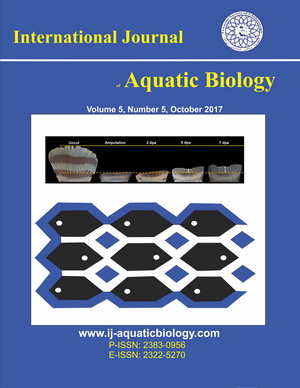Quantifying how spatial resolution affects fish distribution model performance and prediction: A case study of Caspian Kutum, Rutilus frisii
Downloads
The present study aimed to investigate the effect of spatial resolution of data on distribution modelling performance for the Caspian Kutum, Rutilus frisii. A set of spatial resolutions (4, 8, 16, 32, and 64 km) were considered in the modelling analyses, using sea surface temperature, chlorophyll-a concentration, particulate organic carbon content, bottom slope, and depth as environmental predictors of fish catch-per-unit-of-effort (CPUE). The boosted regression trees (BRT) method was applied as the modelling technique. The results showed considerable reductions in data variability (coefficient of variation (%) and variance) with decreasing spatial resolution for most environmental variables and CPUEs. The model performance (adj-R2) was improved with decreasing resolutions, but the best prediction ability of the models was obtained with the BRTs fitted on the lowest resolutions (i.e. 4 and 8 km). While sea surface temperature was the main influencing predictor in the fitted BRTs at all resolutions, resolution-dependence differences were observed in the significance and response curves of other predictors of the models across the spatial resolutions. Overall, our findings indicated that using different levels of spatial resolution highly affects the modelling process, with more relevant explanations and higher prediction power using finer resolutions.
Downloads
Anderson O.F., Guinotte J.M., Rowden A.A., Clark M.R., Mormede S., Davies A.J., Bowden D.A. (2016). Field validation of habitat suitability models for vulnerable marine ecosystems in the South Pacific Ocean: Implications for the use of broad-scale models in fisheries management. Ocean and Coastal Management, 120: 110-126.
Austin M.P., Van Niel K.P. (2011). Improving species distribution models for climate change studies: Variable selection and scale. Journal of Biogeography, 38: 1-8.
Becker E.A., Forney K.A., Ferguson M.C., Foley D.G., Smith R.C., Barlow J., Redfern J.V. (2010). Comparing California Current cetacean–habitat models developed using in situ and remotely sensed sea surface temperature data. Marine Ecology Progress Series, 413: 163-183.
Bellier E., Certain G., Planque B., Monestiez P., Bretagnolle V. (2010). Modelling habitat selection at multiple scales with multivariate geostatistics: An application to seabirds in open sea. Oikos, 119: 988-999.
Collingham Y.C., Wadsworth R.A., Huntley B., Hulme P.E. (2000). Predicting the spatial distribution of non-indigenous riparian weeds: issues of spatial scale and extent. Journal of Applied Ecology, 37: 13-27.
Cooke S.J., Martins E.G., Struthers D.P., Gutowsky L.F.G., Power M., Doka S.E., Dettmers J.M., Crook D.A., Lucas M.C., Holbrook C.M., Krueger C.C. (2016). A moving target-incorporating knowledge of the spatial ecology of fish into the assessment and management of freshwater fish populations. Environmental Monitoring and Assessment, 188: 1-18.
de Knegt H.J., van Langevelde F., Coughenour M.B., Skidmore A.K., de Boer W.F., Heitkönig I.M.A., Knox N.M., Slotow R., van der Waal C., Prins H.H.T. (2010). Spatial autocorrelation and the scaling of species–environment relationships. Ecology, 91: 2455-2465.
Dyer J.J., Brewer S.K., Worthington T.A., Bergey E.A. (2013). The influence of coarse-scale environmental features on current and predicted future distributions of narrow-range endemic crayfish populations. Freshwater Biology, 6: 1071-1088.
Eagderi S., Mouludi-Saleh A., Esmaeili H.R., Sayyadzadeh G., Nasri M. (2022). Freshwater lamprey and fishes of Iran: a revised and updated annotated checklist-2022. Turkish Journal of Zoology, 46(6): 500-522.
Elith J., Leathwick J.R., Hastie T. (2008). A working guide to boosted regression trees. Journal of Animal Ecology, 77(4): 802-813.
Elith J., Leathwick J.R. (2009). Species distribution models: ecological explanation and prediction across space and time. Annual Review of Ecology, Evolution and Systematics, 40: 677-697.
Elith J., Graham C.H. (2009). Do they? How do they? Why do they differ? On finding reasons for differing performances of species distribution models. Ecography, 32: 66-77.
Esmaeili H.R., Brian W.C., Mehraban H.R., Masoudi M., Khaefi R., Abbasi K., Mostafavi H., Vatandoust S. (2015). An updated checklist of fishes of the Caspian Sea basin of Iran with a note on their zoogeography. Iranian Journal of Ichthyology, 13: 152-184.
Fernandez M., Yesson C., Gannier A., Miller P.I., Azevedo J.M.N. (2018). A matter of timing: How temporal scale selection influences cetacean ecological niche modelling. Marine Ecology Progress Series, 595: 217-231.
França S., Cabral H. (2016). Predicting fish species distribution in estuaries: Influence of species' ecology in model accuracy. Estuarine, Coastal and Shelf Science, 180: 11-20.
Froeschke J.T., Froeschke B.F. (2016). Two-stage boosted regression tree model to characterize southern flounder distribution in Texas estuaries at varying population sizes. Marine and Coastal Fisheries, 8(1): 222-231.
García-Callejas D., Araújo M.B. (2016). The effects of model and data complexity on predictions from species distributions models. Ecological Modelling, 326: 4-12.
Garcia-Charton J.A., Petez-Ruzafa A., Sanchez-Jerez P., Bayle-Sempere J.T., Renones O., Moreno D. (2004). Multi-scale spatial heterogeneity, habitat structure, and the effect of marine reserves on Western Mediterranean rocky reef fish assemblages. Marine Biology, 144: 161-182.
GEBCO. (2021). General bathymetric chart of the oceans. https://www.gebconet/data_and_products/gridded_bathymetry_data
Guisan A., Graham C.H., Elith J., Huettmann F. (2007). Sensitivity of predictive species distribution models to change in grain size. Diversity and Distributions, 13: 332-340.
Guisan A., Thuiller W., Zimmermann N.E. (2017). Habitat suitability and distribution models. With applications in R. Cambridge University Press. 478 p.
Hale R., Colton M.A., Peng P., Swearer S.E. (2019). Do spatial scale and life history affect fish-habitat relationships? Journal of Animal Biology, 88: 439-449.
Hijmans R.J. (2024). Raster: Geographic data analysis and modeling. R package version 3.6-30. http://CRAN.R-project.org/package=raster
Kärcher O., Frank K., Walz A., Markovic D. (2019). Scale effects on the performance of niche-based models of freshwater fish distributions. Ecological Modelling, 405: 33-42.
Lecours V., Devillers R., Schneider D.C., Lucieer V.L., Brown C.J., Edinger E.N. (2015). Spatial scale and geographic context in benthic habitat mapping: a review and future directions. Marine Ecology Progress Series, 535: 259-284.
Luoto M., Virkkala R., Heikkinen R.K. (2007). The role of land cover in bioclimatic models depends on spatial resolution. Global Ecology and Biogeography, 1: 34-42.
McPherson J.M., Jetz W. (2007). Effects of species’ ecology on the accuracy of distribution models. Ecography, 30: 135-151.
MODIS. (2021). Moderate Resolution Imaging Spectroradiometer, United States National Aeronautics and Space Administration (NASA) Goddard Space Flight Center. Ocean Laboratory Laboratory. http://modei.gsfc.nasa.gov/
Moëzzi F., Poorbagher H., Eagderi S., Feghhi J., Dormann C.F., Khorshidi Nergi S., Amiri K. (2022). Modelling habitat preference of Caspian Kutum, Rutilus kutum, using non-linear habitat suitability indices and generalized additive models. Regional Studies in Marine Science, 56: 102715.
Moëzzi F., Poorbagher H., Eagderi S., Feghhi J., Dormann C.F., Khorshidi Nergi S., Amiri K. (2022). The importance of temporal scale in distribution modeling of migratory Caspian Kutum, Rutilus frisii. Ecology ad Evolution, 14(9): e70259
Nunez-Riboni I., Akimova A., Sell A.F. (2021). Effect of data spatial scale on the performance of fish habitat models. Fish and Fisheries, 22: 955-973.
Núñez-Riboni I., Taylor M.H., Kempf A., Püts M., Mathis M. (2019). Spatially resolved past and projected changes of the suitable thermal habitat of North Sea cod (Gadus morhua) under climate change. ICES Journal of Marine Science, 76: 2389-2403.
Nyström Sandman A., Wikström S.A., Blomqvist M., Kautsky H., Isaeus M. (2013). Scale-dependent influence of environmental variables on species distribution: a case study on five coastal benthic species in the Baltic Sea. Ecography, 36(3): 354-363.
Pearson R.G., Dawson T.P., Liu C. (2004). Modelling species distributions in Britain: A hierarchical integration of climate and land-cover data. Ecography, 27: 285-298.
Pittman J.P., Brown A.B. (2011). Multi-scale approach for predicting fish species distributions across coral reef seascapes. PLoS ONE, 6(5): e20583.
R Development Core Team (2024). R: A language and environment for statistical computing. Vienna, Austria: R Foundation for Statistical Computing.
Rabazanov N.I., Orlov A.M., Abdosamadov A.S., Barkhalov R.M. (2019). Caspian Kutum Rutilus kutum: A story of exploitation, survival, and revival. In: H.C. Krueger, W.W. Taylor (Eds.), From catastrophe to recovery: Stories of fishery management success. American Fisheries Society. pp: 485-508.
Rahbek C., Graves G.R. (2001). Multiscale assessment of patterns of avian species richness. Proceedings of the National Academy of Sciences, 8: 4534-4539.
Redfern J.V., Barlow J., Ballance L.T., Gerrodette T., Becker E.A. (2008). Absence of scale dependence in dolphin–habitat models for the eastern tropical Pacific Ocean. Marine Ecology Progress Series, 363: 1-14.
Ridgeway G., Developers G. (2024). gbm: Generalized boosted regression models. R package version 2.2.2. http://github.com/gbm-developers/gbm.
Ross L.K., Ross R.E., Stewart H.A., Howell K.L. (2015). The influence of data resolution on predicted distribution and estimates of extent of current protection of three “listed” deep-sea habitats. PLoS One, 10(10): e0140061.
Rushton S.P., Ormerod S.J., Kerby G. 2004. New paradigms for modelling species distributions? Journal of Applied Ecology, 41: 193-200.
Scales K.L., Hazen E.L., Jacox M.G., Edwards C.A., Boustany A.M., Oliver M.J., Bograd S.J. (2016). Scale of inference: on the sensitivity of habitat models for wide-ranging marine predators to the resolution of environmental data. Ecography, 39: 001-011
Seo C., Thorne J.H., Hannah L., Thuiller W. (2009). Scale effects in species distribution models: Implications for conservation planning under climate change. Biology Letters, 1: 39-43.
Thuiller W., Lavorel A., Araújo M.B., Sykes M.T., Prentice I.C. (2005). Climate change threats to plant diversity in Europe. Proceedings of the National Academy of Science USA, 23, 8245.
Tobalske C. (2002). Effects of spatial scale on the predictive ability of habitat models for the Green Woodpecker in Switzerland. In: J.M. Scott, P.J. Heglund, F. Samson, J. Haufler, M. Morrison, M. Raphael, B. Wall (Eds.), Predicting species occurrences: Issues of accuracy and scale. Island Press. pp: 197-205.
Copyright (c) 2024 International Journal of Aquatic Biology

This work is licensed under a Creative Commons Attribution 4.0 International License.








